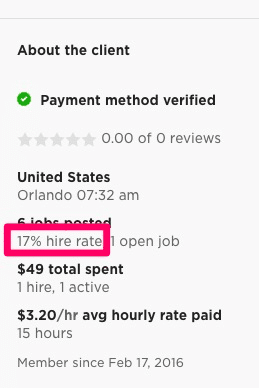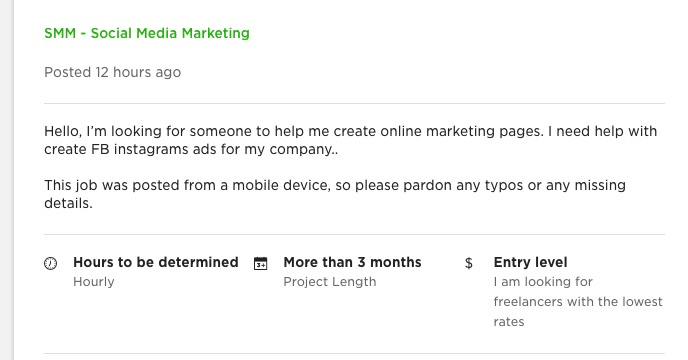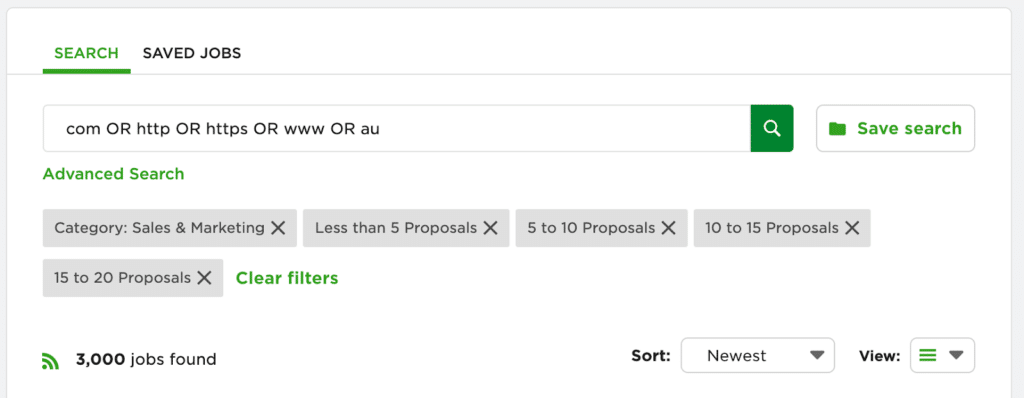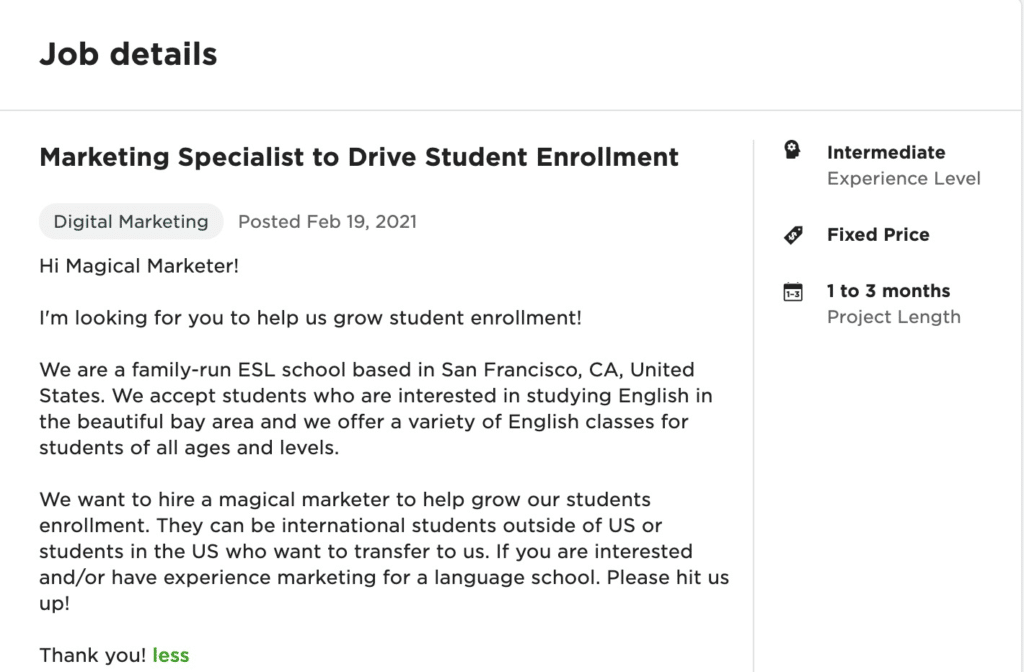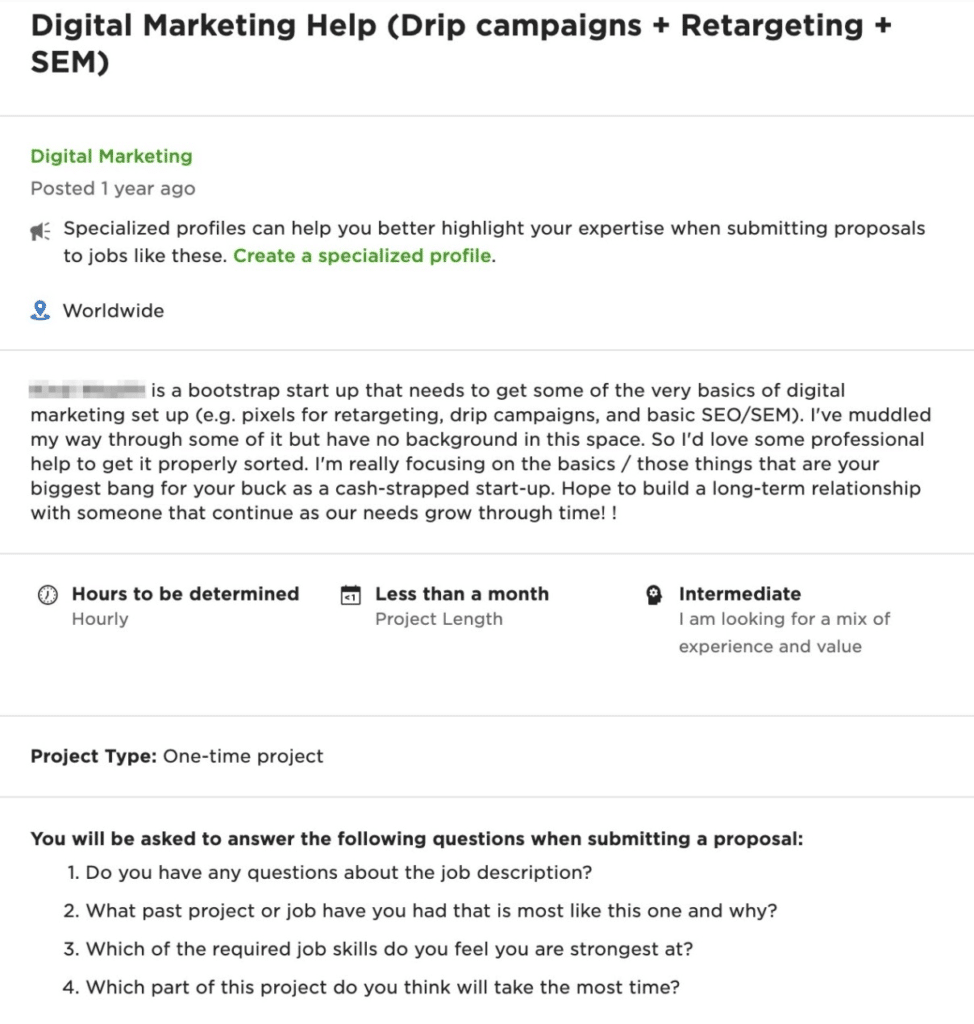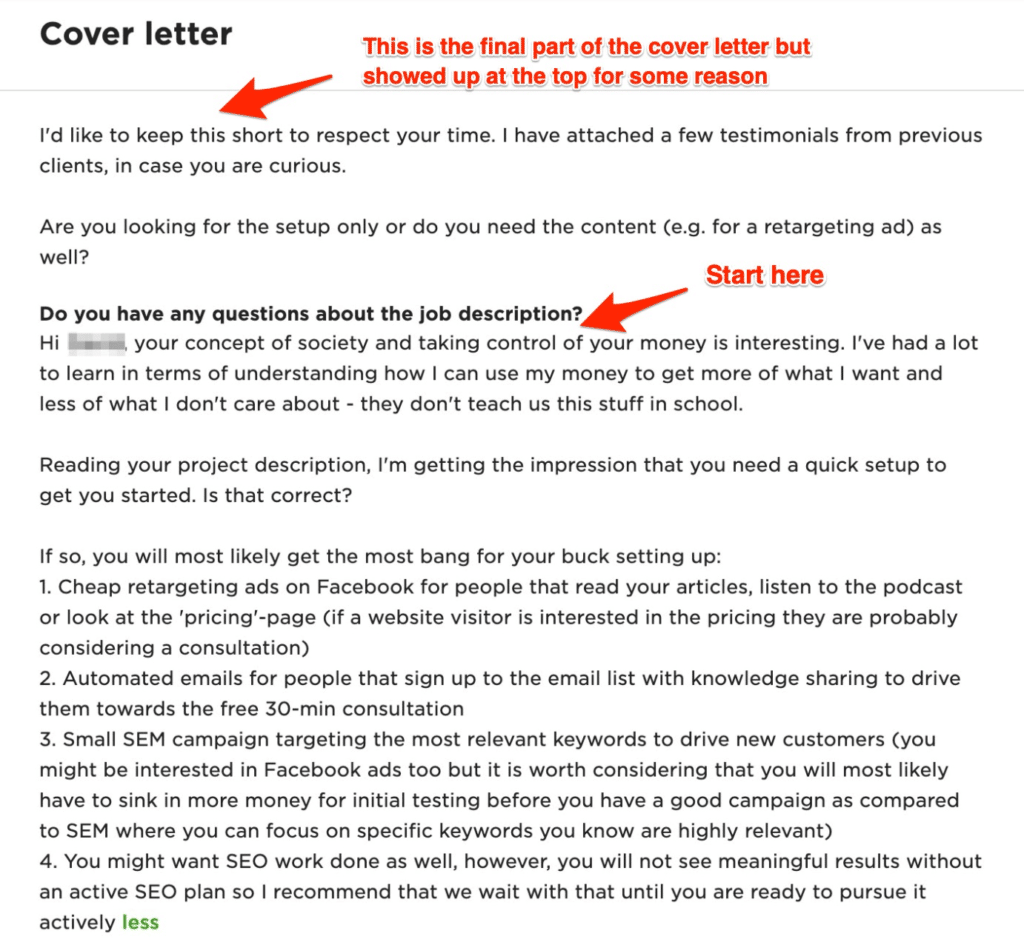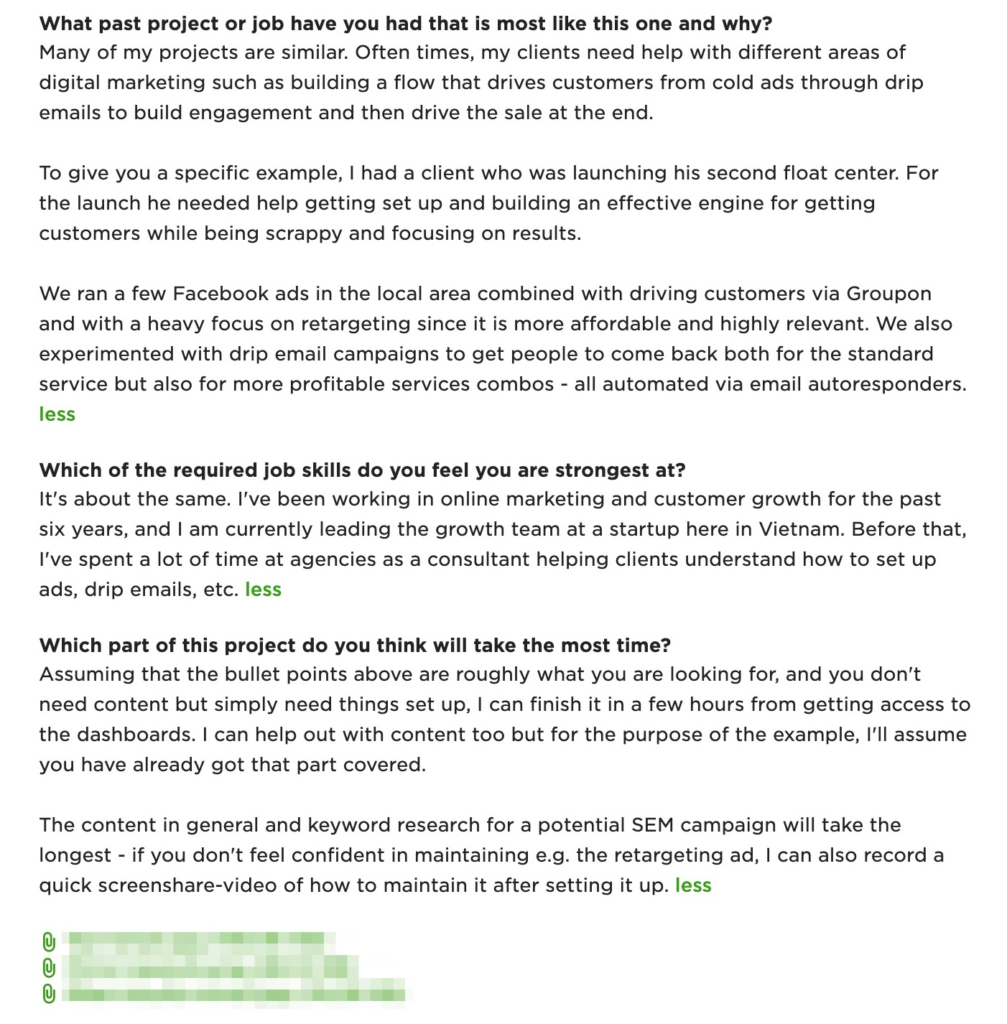One of the most frustrating things as a freelancer is sending Upwork proposals and never hearing back. There is no way around it. It doesn’t feel good to spend hours putting together just the right ideas and then… crickets.
After experimenting and tracking my own Upwork proposal responses, I discovered that it usually comes down to three things:
- Our proposal wasn’t the best one
- Our pricing isn’t in the right ballpark of what the client was looking for
- We’ve applied for a job that the owner isn’t particularly committed to moving forward with
With practice, we can write great Upwork proposals, but the two other points are only somewhat within our control. If our Upwork rates don’t fit the client, we can either lower them or look for other clients, but it’s hard to know when sending the proposal since most projects don’t have enough information to gauge that upfront.
I know of some experienced Upwork freelancers that lead with pricing, which is usually not a great idea, but because they’ve wasted so much time pitching clients that could never afford their rates it works for them.
Money Note: If an extra $1K–$5K/month would change your 2026 goals (debt, savings, travel, freedom), you’ll want to catch this: free live workshop from a freelancer who’s earned $4M+ online. No fluff. No gimmicks. A real roadmap. 👉 Watch the training or save your seat here »
At one point, I ran the math on my Upwork proposals to understand where they fell short and what I could do to land more projects. In a minute, I’ll show you the results but before we dive in, let’s make this a fun little quiz.
Which of the three points above do you think had the biggest impact on whether the client would respond to the Upwork proposals? The proposal itself, the rate, or the commitment of the client to begin the project?
Drumroll, please…
I discovered that about 55% of all the projects I applied for never hired any freelancer from Upwork. HALF. And I didn’t spend my ‘Connects’ machine-gunning proposals everywhere. I carefully selected the jobs and sent each one a personalized proposal.
It’s hard to say why. It could be because their business priorities changed and they didn’t need to complete the project, after all, perhaps they couldn’t find the right fit or they might’ve already found the right freelancer outside of Upwork.
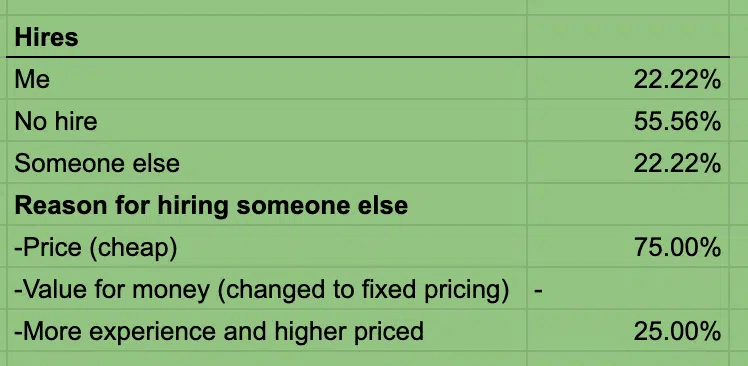
This is the result of one proposal ‘batch’. I tracked several and each one contained 20 proposals – the results of each batch were almost identical.
After each project was closed I checked who the client hired and worked to figure out why. I managed to land about 22% of all the jobs I applied for while someone else got hired for the remaining 22% – most often it was someone who had chosen more affordable hourly rates. That means for every five proposals I sent, I’d land a new client.
What can you do to stack the odds in your favor?
Ending your client slump on Upwork this week
Since you can’t control if a client is ready to start the project, you can only do your best to minimize applying for jobs that are unlikely to go anywhere. Instead, let’s focus on the aspects we can control:
- The projects you find and apply for
- How you apply for them
If you are ready to do something about the frustrating experience of not landing clients, there are two ways to end your client slump: write a different style of proposals or expand beyond freelance websites.
I wouldn’t avoid Upwork proposals if you have tried applying for jobs and haven’t been able to get responses yet. If you can find relevant jobs to apply to, it means that there’s something we need to tweak in the proposals rather than abandoning the idea altogether.
On the other hand, if you have a hard time finding projects you are excited about, it might be a good sign to move away from the website.
In this article, we’ll discuss how to write Upwork proposals that get client responses and what it looks like to move away from freelance websites altogether.

Attract clients with your Upwork proposals
There are two things I’ve found to make the biggest difference when landing jobs on Upwork:
- Applying for jobs with enough details to write a good proposal
- Writing a personal proposal to each client
I’ll explain each one individually. Let’s dive in!
Finding great Upwork projects
The easiest way to stand out in the sea of proposals clients tend to get, is to share something personal you have in common with them to show mutual interest.
For example, if the client needs help with their blog about living abroad, you might share your experience studying abroad.
I’ve found that a bad job description often makes it feel virtually impossible to write something relevant and win over the client. Life is much easier if we apply for jobs where we have enough information upfront to write something specifically for them.
It can take a while to dig up great projects and, in my experience, it’s not often you’ll come across more than a handful of good ones each day. I’ve noticed that applying for a couple of the most exciting ones each day worked better than batch-applying for a stack of them in one day.
There are always new jobs coming and I’ve found that jobs that are more than a few days old or have 20+ proposals tend to be harder to get.
I also like to look at the number of projects the client has hired for. If it is less than about 35%, I’m reluctant to send a proposal because there is a high chance they won’t hire.
We can often ignore the project budget as many clients simply don’t know what to enter. They might be afraid of being overcharged and just put something random like $100.
In fact, I’ve found this principle to hold true for many of the features Upwork allows clients to add.
Another one is when they have to pick if they want a freelancer that is entry-level, intermediate, or expert. It seems kinda random what clients put there and often you’ll see those that want an expert but only want to pay $5/hour.
All of these filters are good, but the best indicator is the job description itself.

When looking at projects, I use this simple rule of thumb: does the job description give enough information for me to write a personalized proposal specifically for this project?
This is a great example of a job that makes it challenging to send a personalized proposal. The client is vague about what they want and shares no details that allow you to dive deeper and show them how good you are.
The good news is that you can save yourself some time by playing around with Upwork’s brilliant “Save search” feature. That way, you can save the searches that gave you the best results and reuse them in the future.
I landed my first client because I noticed a project from my home country and spoke to the client in our native language, which made things more convenient for him. I found this client by using the search filters to find clients with my native language or from my home country.
My favorite Upwork saved searches
Upwork says that clients shouldn’t add their personal info or websites directly in the project description but they still do it. My perhaps all-time favorite search has been to look for projects with the specific websites listed right there.
Not because I want to contact them outside Upwork, but because it allows me to deeply research their business and write a customized proposal with direct ideas for their business. It usually gets their attention. Here’s what that search looks like:
As you can see, I’ve used the “OR” operator which tells Upwork to search for A or B. That way, I can list out the things that I know are likely to be put as part of the website like www or .com, which are typically not used in any other words. You can even add your service as an extra keyword or category to narrow down the search even further.
The more familiar you become with the type of keywords that clients use, the better you’ll be able to find them. For example, if you want to work specifically with startups, you might know that they often talk about growth as a department where not as many other types of businesses do the same. Knowing that you might search like this:
When you’ve found an exciting project with a detailed project description (like the one below), it’s time to write a killer proposal.
Writing killer Upwork proposals
It might seem counterintuitive but a good proposal is often not one that lands the project right then and there but simply gets the client to write you back. That way, you can better understand if they are a good fit for you before you dive deeper, and it’s easier for a client to decide to learn more about you than to award them the project on the spot.
The word ‘proposal’ can feel a bit misleading and ‘cover letter’ is a more relevant term when you think about what it should include.
That means you usually don’t include pricing but instead, work to understand what the client needs more specifically, what problem they are trying to solve, and which part of your experience is relevant for this particular project.
If we continue with the project description example above, here’s a proposal that landed a response:
Hi there, I couldn’t find your name anywhere. I’ve worked with many language courses before, for both German, Italian, Japanese, Chinese, and I created my own course teaching Danish.
Please ignore the pricing for now. Before we decide, we’ll need to figure out what to do to bring results. I’d love to hear more about targets and what you’ve done in the past.
I’ve written a few articles on my approach to driving sales specifically for language schools but it seems like Upwork doesn’t allow me to share them directly in this proposal.
Would you be able to send me a message? That way we are able to interact and that should allow me to share the articles with you. Thanks!
The writeback:
Hi Aske,
Thanks for applying for this project. I’d love to learn more about what you did for your previous clients and how you can help us achieve our goals. Would you be up for a quick call sometime next week?
What do you notice in the example? Why do you think it worked?
It starts out with something we have in common and then goes on to suggest that I’ll need more information to better gauge how I might be able to help along with pointing out specific examples of relevant experience that are attached (e.g. only that related to their industry rather than my entire CV).
This isn’t one of the world’s best Upwork proposals and that’s exactly the point – even so, the relevancy of what we have in common and the few specific examples I wanted to share makes the difference.
Compare that to these proposals for another, similar content project:
Hello,
I’m interested in working on your project. I understand that the quality of content matters most to you and so, strive to deliver to your expectation. I take instruction seriously to deliver content that is in line with what you are looking for. More to this, I ensure you get the work as early as possible within the set timelines. Feel free to discuss with me what you need for a successful project.
Kind regards,
NAME
—
Hi there,
I won’t bore you with a long story as I know you’re going to have lots of proposals to read to find the appropriate freelancer for your project.
I’m a native English speaker with years of experience writing for blogs, college magazines, fashion magazines, news outlets, SEO contents, technical documentation, etc
All the content will be 100% unique, error-free, and appealing to your readers, as you want.
Expect the following:
=> 100% unique content
=> Excellent grammar and punctuation
=> Appealing content to your readers
=> Timely submission of work
Thanks for your time and consideration. I look forward to working with you.
—
Good day, I am NAME. I would like to work with your project and I can surely provide the details you have specified on the project description. I am a [X] graduate, I am new at freelancing but I can confidently say that I am knowledgeable enough to finish your required task. I hope I can get a response. Thank you!
Sincerely,
NAME
Do you notice how vague they are?
Not to mention that the things they highlight (high-quality content, unique content, etc.) are easy to claim but the proposals are hinting at the opposite by being dreadfully generic. In fact, all of those qualities are table stakes – they are expected just to get in the room, not as an impressive way to stand out.
Here’s another example of a project that got a response. The project description:
I have a course to teach UX Design ready.
I’m looking for an experienced consultant that can plan and guide me through a comprehensive launch strategy – with webinars, magnets, etc.
Also to set me up FB ad and the like.
I’m a great creative and I need an experienced guide to success.
I’ve had some success here and there but I need a serious plan for my next launch!
The proposal:
Hey NAME, I remember when I made my first few sales from my online course. It’s an exhilarating experience — you must be excited!
Your project description didn’t mention a particular product price, so I’ll give you a brief example of how to generate sales with Facebook ads for a $50-$100 online course and we can talk specifics if it’s different.
Courses sell differently on Facebook and the whole process can be divided into three categories based on your future product’s price:
1. Less than $50
2. $50-$100
3. Higher than $100
Because people need more persuasion to buy an expensive product than a cheap one. So assuming that you are in fact selling a $50-$100 online course, I’ll build a funnel that:
1. Targets look-alike audiences with videos (based on your current customers)
2. Retarget people that watched the majority of the video, send them to the website, and ask them to sign up for the newsletter
3. Retarget and email them based on the products they looked at
If you are selling a cheap course we can link it directly from the Facebook ad to the sales page but we need to split-test more on audience configuration, images, copy, and sales page to generate profitable sales.
This is a simplified version just to give you an idea of what works and how I do it. I’m sure you are busy, so I’ll keep this short for now. I’ve attached a few testimonials from clients with similar projects, in case you are interested.
Out of curiosity, how much does your course cost and do you have an audience you’ve already sold to or do we need to drive customers from somewhere else?
The writeback:
The course is $1300. [Calendly link to book a meeting]
When the client gets a sea of generic proposals, your specific one stands out. The job description for this project was fairly specific with some direction but still left some questions, so the attack plan was to share an example of how things could be done and then hear what they’ve tried in the past.
Upwork proposal mistakes that screams ‘don’t hire me’
The first proposal mistake I often see is not showing that we took the time to care for the client rather than sending something quickly.
That means looking for their name in the reviews of previous projects or pointing out that we can’t find it to show that we tried. It also means treating the client like a human being who might not know our field of expertise as well as we do and catering to them by explaining things in plain English.
The second mistake is telling them about our expertise in a generic way like, “I have X years of experience, I have ABC skills” or throwing our entire portfolio at them. Instead, curate it and guide them by highlighting specific examples and explaining why those fit the client’s project. Don’t let them guess because they won’t.
Sharing specific insights about their project or industry is powerful. For example, if you work with the language learning industry, you might share that you’ve noticed that students often find it difficult to practice speaking a foreign language because they don’t want to feel stupid saying something wrong.
Or if you work with logo design, you might highlight that for a business with lots of printed material, changing logos can be expensive because of all the reprinting so it will be very expensive if they don’t get it right the first time.
Here’s another Upwork proposal example to summarize:
The job description:
The Upwork proposal:
To my surprise, they were so happy with the project that they even added a 25% bonus to my total earnings (woohoo!).
Expanding beyond Upwork proposals
If it’s challenging to find projects you are excited about on freelance websites, another approach is to reach out to businesses directly in order to land work. It can feel scary at first, as they haven’t put up any job ads and you might not want to come across as sleazy and spammy.
It turns out that you don’t have to be but before we go into that, allow me to share an example of what happened before and after I began landing freelance clients directly. It was a surprising experience to say the least.
Some years ago I quit my job and began freelancing on Upwork full time. At first, I landed a big project and life was great! But it turned out to be surprisingly challenging to find the next long-term project. While I had left my job and was technically living my idea of my dream life, it didn’t feel the way I thought it would.
Something wasn’t right.
I was completing 10-15 billable hours per week for clients. Then another 30 or so pitching new clients that on average would pay about $650 before Upwork’s fees and tax. Almost all my time was spent sending proposals.
During the day, I would scour Upwork’s newsfeed for hidden gems–that rare project that might have a chance of lasting longer than a week or two.
Like an addiction, I’d check it two or three times every day, using filters that I had carefully optimized to find the best projects. Sometimes I’d even try to defend a vague job description that clearly took someone two seconds to put together, and tell myself that I should be more open-minded – that the client was probably just busy.
It was never the case.
Since then, I’ve tried my luck elsewhere, also working 10-15 billable hours per week but without pitching anyone for months. Every now and then I’ve taken on another client when it felt like a good fit, often doubling or tripling my earnings that month. My clients send me new projects without a pitch, never argue about my rates and love the work we do together. It’s a totally different experience.
It feels like freedom.
There were especially three things I noticed from this experience:
- Good clients tend to pay more AND are easier to work with
- They often like to work with people they already trust for new projects as finding someone to trust can be harder than developing good technical skills
- They might be more focused on how the freelancer can solve their problem and be a pleasure to work with than their past experience
If this has made you curious, there are a few places to find clients without freelance websites.
Where to find clients (if not on freelance websites)
There are many ways to go about it and they usually all work but have different benefits. For example, writing articles sharing your expertise like this one on running Google ads for doctors or this one on finding the right healthcare keywords, is a good way to get clients coming to us but takes a while to get off the ground.
On the other hand, the quickest way to land clients that I know of is by reaching out to them first. The medium, whether LinkedIn, email or Instagram DM, matters less than what we tell them.
You can either find them via Google search or using a service like SolidGigs that gathers businesses already looking for freelance help.
When you have found a business you’d like to work with, it works well to pitch them by following a similar structure to what we do on Upwork. First, suggest ideas and then move on to a discovery phone call followed by a summary proposal with pricing.
If you’ve ever worked at a corporation, you’ve probably gotten horribly spammy emails that you’d never respond to and figure that’s the only way to find new clients.
While there are many who buy long lists of random emails and spam them with a generic message, there’s another way that tends to work better and doesn’t make you feel horrible.
The idea is as simple as talking to them like you would if you had a conversation face to face in real life. Treating them like a human being instead of a number in a spreadsheet can make potential clients be surprisingly interested in your services – even if you are a stranger reaching out.
That means finding mutual ground to connect with them instead of a generic message like “I like your stuff”.
If you are curious about this approach, check out the program Cold Emails That Convert.
Takeaways
- If you can’t find any exciting jobs on freelance websites, it might be worth finding clients elsewhere. If you can find exciting projects but your Upwork proposals don’t get responses, work on personalizing them more to each specific project
- The key to writing a proposal that gets responses on Upwork is writing fewer proposals and spending more time on each one, which is easier if the job description is detailed
- Going beyond freelance websites to find clients doesn’t have to be by sending spammy emails, there is a way to do it that doesn’t make you feel sleazy
Upwork can be a terrific way to take your first step towards freedom and begin earning money online but if you can’t find any gigs you are excited about, it might be worth looking elsewhere.
Keep the conversation going...
Over 10,000 of us are having daily conversations over in our free Facebook group and we'd love to see you there. Join us!


